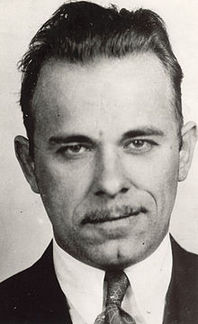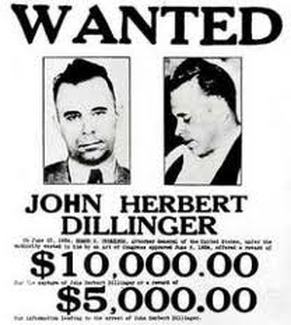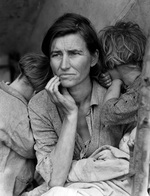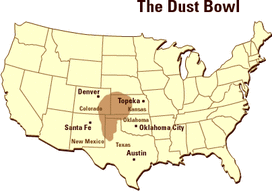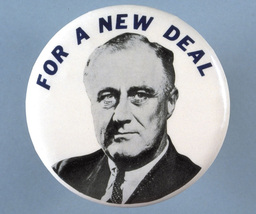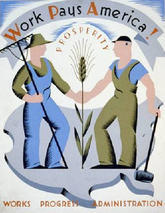The 1930S
Biography:
John Dillinger went from small time crook to America's Most Wanted after an ill-fated bank robbery left a police officer dead. By modern standards, Dillinger's crimes seem relatively tame, but being named Public Enemy No. 1 gave him legendary status.
Born in Indianapolis on June 22, 1903, John Herbert Dillinger Jr. grew up on Cooper Street near the Massachusetts Avenue railroad tracks on the North-east side. When he was a teenager, his father, a grocer, moved the family to Mooresville, a small farming community near Indianapolis' South-west side. It was there that Dillinger committed his first recorded crime -- a car theft.
In 1924, Dillinger and an ex-con pal held up a 65-year-old Mooresville grocer. But the shopkeeper fought back, and Dillinger was caught and convicted, spending the next nine years in prison.
In 1933, Dillinger committed a string of bank robberies throughout the Midwest and broke out of jail twice with the help of his gang. His "gang" was made up of various prison acquaintances and girlfriends. Sometimes as many as six associated with Dillinger. "Baby Face" Nelson was at one time a member of Dillinger's gang. The first escape was in Ohio, and the second time was in Crown Point, Ind., using a carved wooden handgun. They were well equipped with machine guns, bulletproof vests and fast cars.
In January 1934, Dillinger's gang killed East Chicago police officer William O'Malley during a holdup of the First National Bank. Dillinger was placed in the Lake County Jail at Crown Point. He escaped, stole the sheriff's car and drove across the Illinois state line to Chicago. In doing so, he violated federal law and brought himself to the attention of J. Edgar Hoover and the Federal Bureau of Investigation.
Dillinger shot his way out of numerous FBI traps from St. Paul, Minn. to St. Louis and escaped the FBI at the Little Bohemia Lodge in Wisconsin. That incident was bungled by the FBI, which mistakenly shot three innocent people, killing one. The entire gang escaped.
Dillinger made a mockery of the FBI by eluding capture so many times that director Hoover took it personally. Hoover systematically eliminated Dillinger's gang one by one. Hoover labeled Dillinger "Public Enemy No. 1" and placed a $15,000 price on his head, forcing Dillinger to keep a low profile.
Anna Sage, the infamous "woman in red", with whom Dillinger had been living in a Chicago brothel, betrayed Dillinger. Chicago FBI chief Melvin Purvis was tipped off by Sage that Dillinger would be seeing the movie "Manhatten Melodrama" at the Biograph Theater on Chicago's North side. Sage wore a red dress to alert the FBI that the man she was with was Dillinger.
On July 22, 1934, 15 FBI agents surrounded the theater. Once Purvis identified Dillinger, the agents closed in. Dillinger pulled a gun and the agents opened fire, killing Dillinger. Just three bullets struck Dillinger. The fatal shot passed through the back of his neck and exited just under his right eye. He was shot twice in the chest; one bullet passed through the tip of his heart.
Embalming took place in Chicago at the Cook County morgue before thousands of curious onlookers under the premise that "John Dillinger's fate might be a lesson to the world." Dillinger's body was brought back to Mooresville, Ind., where nearly 10,000 people waited to view his body. Funeral services were held at the home of his sister, Audrey Hancock, in Maywood. Dillinger was buried in Crown Hill Cemetery in Indianapolis.
Not surprisingly, there have been theories that it was not John Dillinger who was killed outside the Biograph Theater, but rather a double. A scar on the left side of his face had apparently been removed by plastic surgery and his fingerprints had been removed by acid. FBI chief Melvin Purvis also noted that Dillinger drew his gun from his pocket the evening he was killed--he usually kept it at his waist.
Source: http://www.indystar.com/article/99999999/NEWS06/80519042/StarFiles-John-Dillinger
Born in Indianapolis on June 22, 1903, John Herbert Dillinger Jr. grew up on Cooper Street near the Massachusetts Avenue railroad tracks on the North-east side. When he was a teenager, his father, a grocer, moved the family to Mooresville, a small farming community near Indianapolis' South-west side. It was there that Dillinger committed his first recorded crime -- a car theft.
In 1924, Dillinger and an ex-con pal held up a 65-year-old Mooresville grocer. But the shopkeeper fought back, and Dillinger was caught and convicted, spending the next nine years in prison.
In 1933, Dillinger committed a string of bank robberies throughout the Midwest and broke out of jail twice with the help of his gang. His "gang" was made up of various prison acquaintances and girlfriends. Sometimes as many as six associated with Dillinger. "Baby Face" Nelson was at one time a member of Dillinger's gang. The first escape was in Ohio, and the second time was in Crown Point, Ind., using a carved wooden handgun. They were well equipped with machine guns, bulletproof vests and fast cars.
In January 1934, Dillinger's gang killed East Chicago police officer William O'Malley during a holdup of the First National Bank. Dillinger was placed in the Lake County Jail at Crown Point. He escaped, stole the sheriff's car and drove across the Illinois state line to Chicago. In doing so, he violated federal law and brought himself to the attention of J. Edgar Hoover and the Federal Bureau of Investigation.
Dillinger shot his way out of numerous FBI traps from St. Paul, Minn. to St. Louis and escaped the FBI at the Little Bohemia Lodge in Wisconsin. That incident was bungled by the FBI, which mistakenly shot three innocent people, killing one. The entire gang escaped.
Dillinger made a mockery of the FBI by eluding capture so many times that director Hoover took it personally. Hoover systematically eliminated Dillinger's gang one by one. Hoover labeled Dillinger "Public Enemy No. 1" and placed a $15,000 price on his head, forcing Dillinger to keep a low profile.
Anna Sage, the infamous "woman in red", with whom Dillinger had been living in a Chicago brothel, betrayed Dillinger. Chicago FBI chief Melvin Purvis was tipped off by Sage that Dillinger would be seeing the movie "Manhatten Melodrama" at the Biograph Theater on Chicago's North side. Sage wore a red dress to alert the FBI that the man she was with was Dillinger.
On July 22, 1934, 15 FBI agents surrounded the theater. Once Purvis identified Dillinger, the agents closed in. Dillinger pulled a gun and the agents opened fire, killing Dillinger. Just three bullets struck Dillinger. The fatal shot passed through the back of his neck and exited just under his right eye. He was shot twice in the chest; one bullet passed through the tip of his heart.
Embalming took place in Chicago at the Cook County morgue before thousands of curious onlookers under the premise that "John Dillinger's fate might be a lesson to the world." Dillinger's body was brought back to Mooresville, Ind., where nearly 10,000 people waited to view his body. Funeral services were held at the home of his sister, Audrey Hancock, in Maywood. Dillinger was buried in Crown Hill Cemetery in Indianapolis.
Not surprisingly, there have been theories that it was not John Dillinger who was killed outside the Biograph Theater, but rather a double. A scar on the left side of his face had apparently been removed by plastic surgery and his fingerprints had been removed by acid. FBI chief Melvin Purvis also noted that Dillinger drew his gun from his pocket the evening he was killed--he usually kept it at his waist.
Source: http://www.indystar.com/article/99999999/NEWS06/80519042/StarFiles-John-Dillinger
Resources
Great Depression
New Deal
Academic Standards for 1930's Lessons:
SS.USH.8.5 2007 Describe social, economic and political issues and how they impact individuals and organizations.
SS.USH.8.6 2007 Analyze the impact of globalization on U.S. economic, political and foreign policy.
SS.USH.9.3 2007 Investigate and interpret multiple causation in historical actions and analyze cause-and-effect relationships.
SS.USH.9.5 2007 Use technology in the process of conducting historical research and in the presentation of the products of historical research and current events.
SS.USH.9.6 2007 Formulate and present a position or course of action on an issue by examining the underlying factors contributing to that issue.
SS.USH.4.4 2007 Describe the stock market crash of 1929 and the impact it had on politics, economics and America's standard of living.
SS.USH.4.5 2007 Identify and describe the contributions of political and social reformers during the Great Depression.
SS.USH.4.6 2007 Describe New Deal legislation and its effect on government expansion and compare and contrast their views of New Deal proponents and
opponents.
9-10.RH.2 Determine the central ideas or information of a primary or secondary source; provide an accurate summary of how key events or ideas develop over the
course of the text.
9-10.RH.4 Determine the meaning of words and phrases as they are used in a text, including vocabulary describing political, social, or economic aspects of
history/social studies.
SS.USH.8.6 2007 Analyze the impact of globalization on U.S. economic, political and foreign policy.
SS.USH.9.3 2007 Investigate and interpret multiple causation in historical actions and analyze cause-and-effect relationships.
SS.USH.9.5 2007 Use technology in the process of conducting historical research and in the presentation of the products of historical research and current events.
SS.USH.9.6 2007 Formulate and present a position or course of action on an issue by examining the underlying factors contributing to that issue.
SS.USH.4.4 2007 Describe the stock market crash of 1929 and the impact it had on politics, economics and America's standard of living.
SS.USH.4.5 2007 Identify and describe the contributions of political and social reformers during the Great Depression.
SS.USH.4.6 2007 Describe New Deal legislation and its effect on government expansion and compare and contrast their views of New Deal proponents and
opponents.
9-10.RH.2 Determine the central ideas or information of a primary or secondary source; provide an accurate summary of how key events or ideas develop over the
course of the text.
9-10.RH.4 Determine the meaning of words and phrases as they are used in a text, including vocabulary describing political, social, or economic aspects of
history/social studies.
